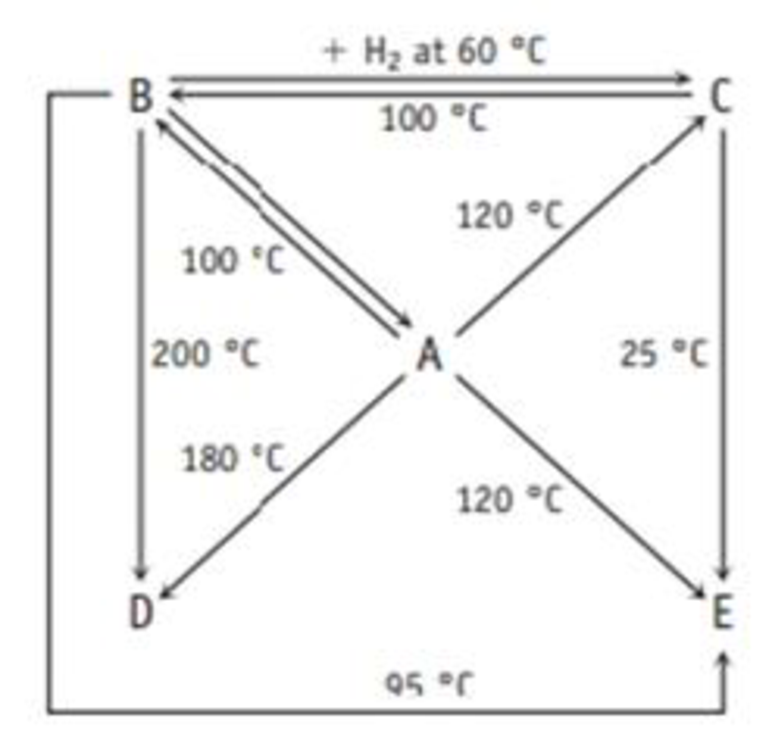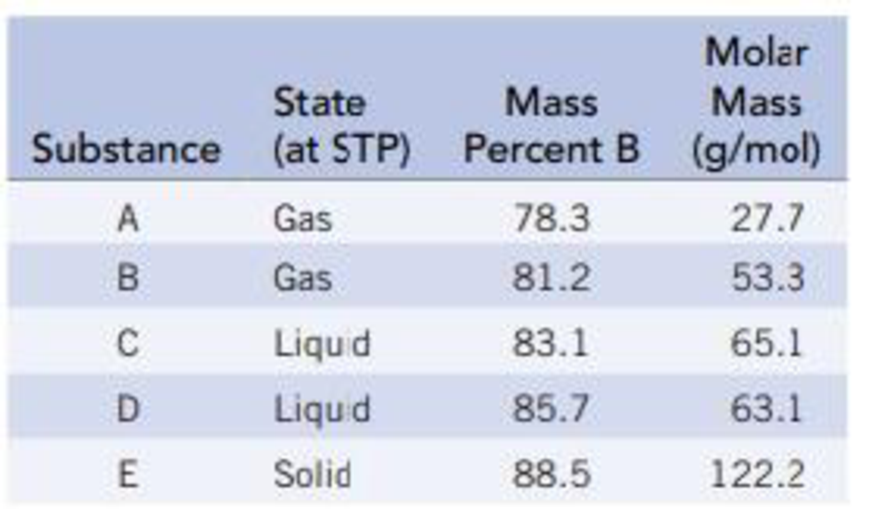
Concept explainers
A Boron and hydrogen form an extensive family of compounds, and the diagram below shows how they are related by reaction.

The following table gives the weight percent of boron in each of the compounds. Derive the empirical and molecular formulas of compounds A-E.

Interpretation: To determine the empirical and molecular formula of given compounds A-E.
Concept introduction:
The empirical formula of a chemical compound is the simplest positive integer ratio of atoms present in a compound.
A molecular formula shows the total number of atoms in a molecule but not their structural arrangement.
Answer to Problem 107GQ
The empirical formula of compound A is BH3 and the molecular formula of compound A is B2H6.
The empirical formula of compound B is BH2.5 and the molecular formula of compound B is B4H10.
The empirical formula of compound C is BH2.2 and the molecular formula of compound C is B5H11.
The empirical formula of compound D is BH1.78 and the molecular formula of compound D is B5H9.
The empirical formula of compound E is BH1.4 and the molecular formula of compound E is B10H14.
Explanation of Solution
Boron and hydrogen form an extensive family of compounds. Substance A-E contains boron and hydrogen atoms.
The empirical and molecular formula of given compounds A-E is calculated below.
Given:
Substance A is a gaseous compound contains 78.3% by mass of boron and 21.7% by mass of hydrogen. The molecular weight of boron is 10.8 g⋅mol−1 and the molecular weight of hydrogen atom is 1.008 g⋅mol−1.
The empirical formula of substance A is calculated as,
Convert the mass of boron and hydrogen into moles using molar mass of boron and hydrogen respectively.
78.3 g10.8 g⋅mol−1=7.25 mol boron21.7 g1.008 g⋅mol−1=21.5 mol hydrogen
Divide each mole value by the smallest number of moles calculated. Round off to the nearest whole number.
7.25 mol boron7.25 mol=1.0021.5 mol hydrogen7.25 mol≈3.00
Thus, the empirical formula of compound A is BH3.
The empirical formula molar mass of compound A is 13.82 g⋅mol−1 and the molecular formula molar mass of compound A is 27.7 g⋅mol−1.
Divide the molecular formula mass by the empirical formula mass,
27.7 g⋅mol−113.8 g⋅mol−1=2.00
Multiply each of the subscripts within the empirical formula of substance A by the number calculated above.
Thus, the molecular formula of substance A is 2(BH3) that is B2H6.
Substance B is a gaseous compound contains 81.2% by mass of boron and 18.8% by mass of hydrogen. The molecular weight of boron is 10.8 g⋅mol−1 and the molecular weight of hydrogen atom is 1.008 g⋅mol−1.
The empirical formula of substance B is calculated as,
Convert the mass of boron and hydrogen into moles using molar mass of boron and hydrogen respectively.
81.2 g10.8 g⋅mol−1=7.52 mol boron18.8 g1.008 g⋅mol−1=18.65 mol hydrogen
Divide each mole value by the smallest number of moles calculated. Round off to the nearest whole number.
7.52 mol boron7.52 mol=1.0018.65 mol hydrogen7.52 mol=2.5
Thus, the empirical formula of compound B is BH2.5.
The empirical formula molar mass of compound B is 12.82 g⋅mol−1 and the molecular formula molar mass of compound B is 53.3 g⋅mol−1.
Divide the molecular formula mass by the empirical formula mass,
53.3 g⋅mol−112.8 g⋅mol−1≈4.00
Multiply each of the subscripts within the empirical formula of substance B by the number calculated above.
Thus, the molecular formula of substance B is 4(BH2.5) that is B4H10.
Substance C is a liquid compound contains 83.1% by mass of boron and 16.9% by mass of hydrogen. The molecular weight of boron is 10.8 g⋅mol−1 and the molecular weight of hydrogen atom is 1.008 g⋅mol−1.
The empirical formula of substance C is calculated as,
Convert the mass of boron and hydrogen into moles using molar mass of boron and hydrogen respectively.
83.1 g10.8 g⋅mol−1=7.69 mol boron16.9 g1.008 g⋅mol−1=16.76 mol hydrogen
Divide each mole value by the smallest number of moles calculated. Round off to the nearest whole number.
7.69 mol boron7.69 mol=1.0016.76 mol hydrogen7.69 mol≈2.2
Thus, the empirical formula of compound C is BH2.2.
The empirical formula molar mass of compound A is 13.02 g⋅mol−1 and the molecular formula molar mass of compound C is 65.1 g⋅mol−1.
Divide the molecular formula mass by the empirical formula mass,
65.1 g⋅mol−113.02 g⋅mol−1=5.00
Multiply each of the subscripts within the empirical formula of substance C by the number calculated above.
Thus, the molecular formula of substance C is 5(BH2.2) that is B5H11.
Substance D is a liquid compound contains 85.7% by mass of boron and 14.3% by mass of hydrogen. The molecular weight of boron is 10.8 g⋅mol−1 and the molecular weight of hydrogen atom is 1.008 g⋅mol−1.
The empirical formula of substance D is calculated as,
Convert the mass of boron and hydrogen into moles using molar mass of boron and hydrogen respectively.
85.7 g10.8 g⋅mol−1=7.93 mol boron14.3 g1.008 g⋅mol−1=14.18 mol hydrogen
Divide each mole value by the smallest number of moles calculated. Round off to the nearest whole number.
7.93 mol boron7.93 mol=1.0014.18 mol hydrogen7.93 mol=1.78
Thus, the empirical formula of compound D is BH1.78.
The empirical formula molar mass of compound A is 12.59 g⋅mol−1 and the molecular formula molar mass of compound D is 63.1 g⋅mol−1.
Divide the molecular formula mass by the empirical formula mass,
63.1 g⋅mol−112.59 g⋅mol−1=5.00
Multiply each of the subscripts within the empirical formula of substance D by the number calculated above.
Thus, the molecular formula of substance D is 5(BH1.78) that is B5H9.
Substance E is a solid compound contains 88.5% by mass of boron and 11.5% by mass of hydrogen. The molecular weight of boron is 10.8 g⋅mol−1 and the molecular weight of hydrogen atom is 1.008 g⋅mol−1.
The empirical formula of substance E is calculated as,
Convert the mass of boron and hydrogen into moles using molar mass of boron and hydrogen respectively.
88.5 g10.8 g⋅mol−1=8.19 mol boron11.5 g1.008 g⋅mol−1=11.41 mol hydrogen
Divide each mole value by the smallest number of moles calculated. Round off to the nearest whole number.
8.19 mol boron8.19 mol=1.0011.41 mol hydrogen8.19 mol=1.4
Thus, the empirical formula of compound E is BH1.4.
The empirical formula molar mass of compound E is 12.11 g⋅mol−1 and the molecular formula molar mass of compound E is 122.2 g⋅mol−1.
Divide the molecular formula mass by the empirical formula mass,
122.2 g⋅mol−112.11 g⋅mol−1=10
Multiply each of the subscripts within the empirical formula of substance E by the number calculated above.
Thus, the molecular formula of substance E is 10(BH1.4) that is B10H14.
The empirical formula of compound A is BH3 and the molecular formula of compound A is B2H6.
The empirical formula of compound B is BH2.5 and the molecular formula of compound B is B4H10.
The empirical formula of compound C is BH2.2 and the molecular formula of compound C is B5H11.
The empirical formula of compound D is BH1.78 and the molecular formula of compound D is B5H9.
The empirical formula of compound E is BH1.4 and the molecular formula of compound E is B10H14.
Want to see more full solutions like this?
Chapter 21 Solutions
Chemistry and Chemical Reactivity - AP Edition
- A covalent bond is the result of the a) b) c) d) e) overlap of two half-filled s orbitals overlap of a half-filled s orbital and a half-filled p orbital overlap of two half-filled p orbitals along their axes parallel overlap of two half-filled parallel p orbitals all of the abovearrow_forwardCan the target compound at right be efficiently synthesized in good yield from the unsubstituted benzene at left? starting material target If so, draw a synthesis below. If no synthesis using reagents ALEKS recognizes is possible, check the box under the drawing area. Be sure you follow the standard ALEKS rules for submitting syntheses. + More... Note for advanced students: you may assume that you are using a large excess of benzene as your starting material. C T Add/Remove step X ноarrow_forwardWhich one of the following atoms should have the largest electron affinity? a) b) c) d) 으으 e) 1s² 2s² 2p6 3s¹ 1s² 2s² 2p5 1s² 2s² 2p 3s² 3p² 1s² 2s 2p 3s² 3p6 4s2 3ds 1s² 2s² 2p6arrow_forward
- All of the following are allowed energy levels except _. a) 3f b) 1s c) 3d d) 5p e) 6sarrow_forwardA student wants to make the following product in good yield from a single transformation step, starting from benzene. Add any organic reagents the student is missing on the left-hand side of the arrow, and any addition reagents that are necessary above or below the arrow. If this product can't be made in good yield with a single transformation step, check the box below the drawing area. Note for advanced students: you may assume that an excess of benzene is used as part of the reaction conditions. : ☐ + I X This product can't be made in a single transformation step.arrow_forwardPredict the major products of this organic reaction:arrow_forward
- Name the family to which each organic compound belongs. The first answer has been filled in for you. compound CH₂ || CH3-C-NH2 0 ။ CH3-C-CH₂ CH=O–CH=CH, CH₂ HO CH2-CH2-CH-CH3 family amine Darrow_forward1b. Br LOHarrow_forwardI would like my graphs checked please. Do they look right? Do I have iodine and persulfate on the right axis ?arrow_forward
 Chemistry: An Atoms First ApproachChemistryISBN:9781305079243Author:Steven S. Zumdahl, Susan A. ZumdahlPublisher:Cengage Learning
Chemistry: An Atoms First ApproachChemistryISBN:9781305079243Author:Steven S. Zumdahl, Susan A. ZumdahlPublisher:Cengage Learning Chemistry & Chemical ReactivityChemistryISBN:9781337399074Author:John C. Kotz, Paul M. Treichel, John Townsend, David TreichelPublisher:Cengage Learning
Chemistry & Chemical ReactivityChemistryISBN:9781337399074Author:John C. Kotz, Paul M. Treichel, John Townsend, David TreichelPublisher:Cengage Learning Chemistry & Chemical ReactivityChemistryISBN:9781133949640Author:John C. Kotz, Paul M. Treichel, John Townsend, David TreichelPublisher:Cengage Learning
Chemistry & Chemical ReactivityChemistryISBN:9781133949640Author:John C. Kotz, Paul M. Treichel, John Townsend, David TreichelPublisher:Cengage Learning ChemistryChemistryISBN:9781305957404Author:Steven S. Zumdahl, Susan A. Zumdahl, Donald J. DeCostePublisher:Cengage Learning
ChemistryChemistryISBN:9781305957404Author:Steven S. Zumdahl, Susan A. Zumdahl, Donald J. DeCostePublisher:Cengage Learning
 Chemistry: The Molecular ScienceChemistryISBN:9781285199047Author:John W. Moore, Conrad L. StanitskiPublisher:Cengage Learning
Chemistry: The Molecular ScienceChemistryISBN:9781285199047Author:John W. Moore, Conrad L. StanitskiPublisher:Cengage Learning





